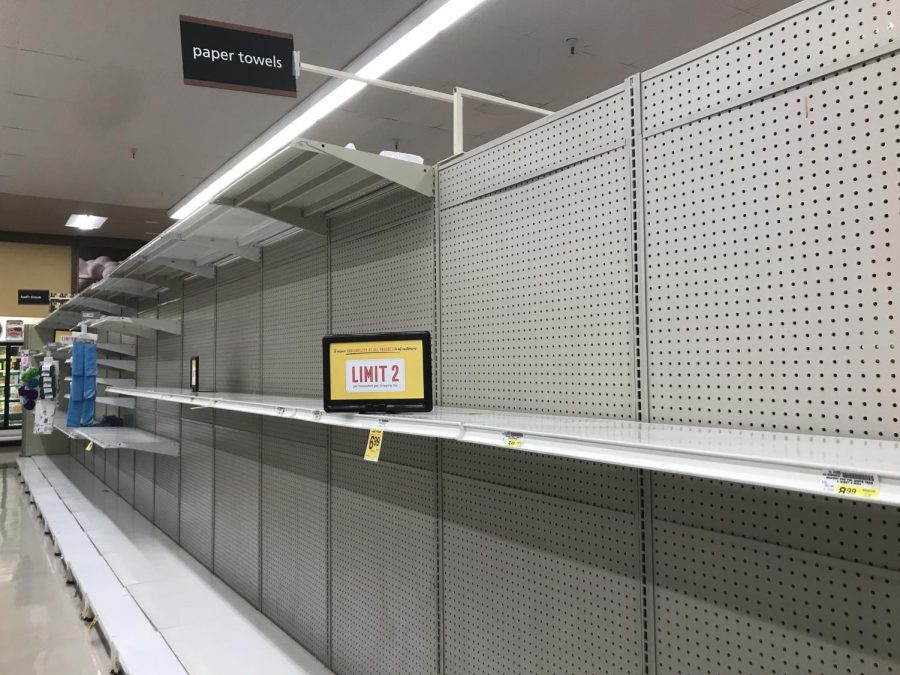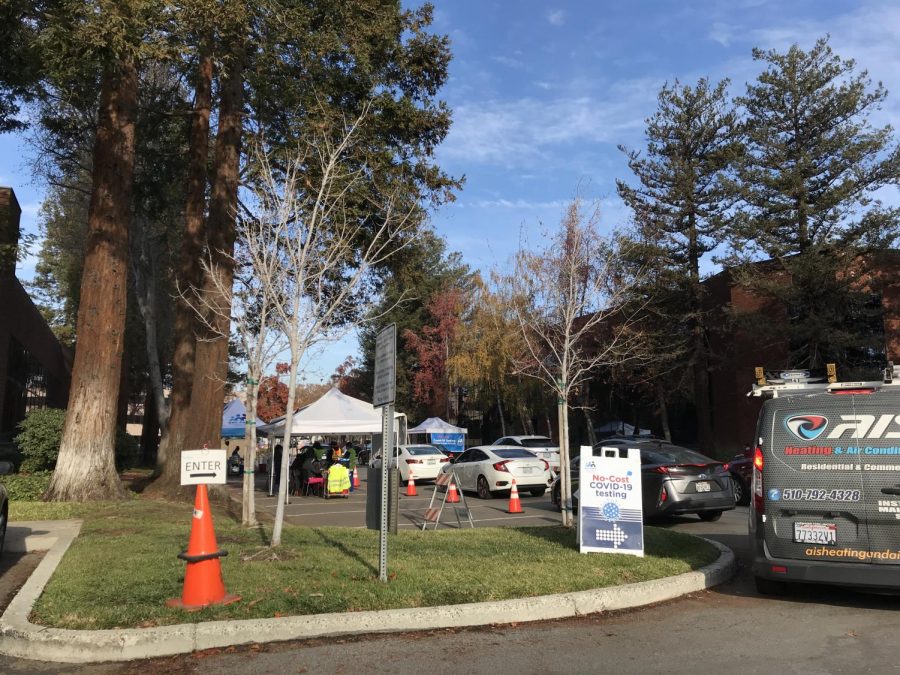Santa Clara County to implement new COVID-19 stay-at-home order
The toiletries aisle at a Safeway store in Saratoga was empty on Nov. 21, as local residents stock up on essential supplies to prepare for the increased county restrictions. Health officials issued a new stay-at-home order, which will go into effect at 10 p.m. today until Jan. 4.
December 6, 2020
Santa Clara County health officials issued a temporary stay-at-home order, which will go into effect at 10 p.m. today in response to a recent surge of COVID-19 cases and hospitalizations in the Bay Area.
The order—which will also affect Alameda, Contra Costa and Marin counties, as well as the City of Berkeley—lasts until Jan. 4 and mandates the shutdown of all nonessential operations except for retail and critical infrastructure. All nonessential travel for the next month is prohibited, as well as any private gatherings among people in different households.
Schools that are currently open can continue to maintain the same operations, so any current activities on the upper school campus are not anticipated to be impacted by the new restrictions. According to Assistant Head of Student Affairs Greg Lawson, there will be no changes until winter break, but the school plans to close programs during the academic day in the first two weeks of January as a preemptive quarantine measure.
“As of now, for the next couple weeks, no changes,” Lawson said. “We’re very aware of them, we’re watching the same statistics everyone else is, we’re concerned and having lots of conversations everyday of the potential impacts.”
With a record 300 hospitalizations and over 3,000 new COVID-19 cases reported in the last week, the county decided to adopt the tougher restrictions almost immediately rather than wait for Governor Gavin Newsom’s original guidelines, which called for the implementation of the order after the Intensive Care Unit (ICU) capacity falls below 15% in the middle of the month. The Bay Area’s ICU capacity, which refers to the percentage of empty beds in ICUs, is currently at 24.1%.
After Santa Clara County moved into the Purple Tier (Tier 1) on Nov. 30, following a surge of new cases caused by Thanksgiving gatherings, upper school students experienced increased restrictions. The athletics program canceled all indoor activities, including boys volleyball open gyms, and the Honors Analytical Chemistry lab scheduled for Dec. 12 is currently being re-considered.
Distanced fitness activities are still scheduled to take place on campus, with ample hygiene and spacing as well as masks when students are not working out. The California Interscholastic Federation (CIF) announced on Dec. 1 that Season 1 sports are on pause until January at the earliest, and boys volleyball has been moved to Season 2.
Teachers who decide to conduct classes on campus are having their temperatures checked everyday and are expected to wear masks whenever they are surrounded by others. According to Lawson, there have been zero incidents of COVID-19 transmission on campus since school closed in March, as of Dec. 4.
“The health and safety of our students and teachers and everyone that works at Harker and in our entire community is most important to us,” Lawson said. “We’re not going to extend into any programming that we don’t feel like we have the safety protocols in place to manage. We’re also going to respect everyone’s individual tolerance in this situation.”
Sectors that will temporarily close include bars, wineries, hair salons and barbershops and personal services. Sectors that will continue to remain open are schools that have received a waiver, critical infrastructure, retail (limited to 20% capacity to reduce exposure) and restaurants (takeout and delivery options).
“We’ve gotten used to being able to go out and about, at least to some extent, and going back to [stay-at-home orders] is definitely rough,” senior Hari Bhimaraju said. “But at the same time, I think [it] will be a good thing, because after the shelter-in-place happened in the beginning of the virus, things got way better. The most important thing is to make sure hospitals aren’t getting overcrowded and that people are getting the help that they need.”
In his press conference last Thursday, Newsom also detailed the state’s plan for distributing the COVID-19 vaccine. The state will receive 327,000 doses between Dec. 12 and 15, and the first doses will be from Pfizer, distributed to essential workers in three tiers. Details on how the vaccine will be distributed can be found here.
“It’s a constantly changing landscape, and I think my only message to everybody is wear that mask, wash your hands—all those things are making a difference, so let’s keep the larger community in a nice little bubble where everyone is trying to stay healthy,” Lawson said.


















![“[Building nerf blasters] became this outlet of creativity for me that hasn't been matched by anything else. The process [of] making a build complete to your desire is such a painstakingly difficult process, but I've had to learn from [the skills needed from] soldering to proper painting. There's so many different options for everything, if you think about it, it exists. The best part is [that] if it doesn't exist, you can build it yourself," Ishaan Parate said.](https://harkeraquila.com/wp-content/uploads/2022/08/DSC_8149-900x604.jpg)




![“When I came into high school, I was ready to be a follower. But DECA was a game changer for me. It helped me overcome my fear of public speaking, and it's played such a major role in who I've become today. To be able to successfully lead a chapter of 150 students, an officer team and be one of the upperclassmen I once really admired is something I'm [really] proud of,” Anvitha Tummala ('21) said.](https://harkeraquila.com/wp-content/uploads/2021/07/Screen-Shot-2021-07-25-at-9.50.05-AM-900x594.png)







![“I think getting up in the morning and having a sense of purpose [is exciting]. I think without a certain amount of drive, life is kind of obsolete and mundane, and I think having that every single day is what makes each day unique and kind of makes life exciting,” Neymika Jain (12) said.](https://harkeraquila.com/wp-content/uploads/2017/06/Screen-Shot-2017-06-03-at-4.54.16-PM.png)








![“My slogan is ‘slow feet, don’t eat, and I’m hungry.’ You need to run fast to get where you are–you aren't going to get those championships if you aren't fast,” Angel Cervantes (12) said. “I want to do well in school on my tests and in track and win championships for my team. I live by that, [and] I can do that anywhere: in the classroom or on the field.”](https://harkeraquila.com/wp-content/uploads/2018/06/DSC5146-900x601.jpg)
![“[Volleyball has] taught me how to fall correctly, and another thing it taught is that you don’t have to be the best at something to be good at it. If you just hit the ball in a smart way, then it still scores points and you’re good at it. You could be a background player and still make a much bigger impact on the team than you would think,” Anya Gert (’20) said.](https://harkeraquila.com/wp-content/uploads/2020/06/AnnaGert_JinTuan_HoHPhotoEdited-600x900.jpeg)

![“I'm not nearly there yet, but [my confidence has] definitely been getting better since I was pretty shy and timid coming into Harker my freshman year. I know that there's a lot of people that are really confident in what they do, and I really admire them. Everyone's so driven and that has really pushed me to kind of try to find my own place in high school and be more confident,” Alyssa Huang (’20) said.](https://harkeraquila.com/wp-content/uploads/2020/06/AlyssaHuang_EmilyChen_HoHPhoto-900x749.jpeg)







